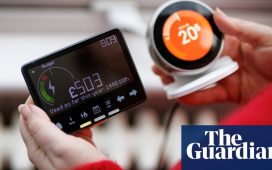This article is an on-site version of our Moral Money newsletter. Premium subscribers can sign up here to get the newsletter delivered three times a week. Standard subscribers can upgrade to Premium here, or explore all FT newsletters.
Visit our Moral Money hub for all the latest ESG news, opinion and analysis from around the FT
Welcome back. Energy price volatility has eased this year as the prices of natural gas and LNG stabilise. That’s bad news for energy traders such as Gunvor, which profited from the unprecedented tumult following the outbreak of the war in Ukraine, and saw its earnings halve in the first six months of 2024.
Read on for Simon’s item on how wind and solar energy, whose supply of power can fluctuate more than that of alternative energy sources, could be paired with new technologies to track — and smooth — demand from consumers. Thanks for reading. — Lee Harris
Transition finance is a growing part of bank lending and a strategy increasingly used by multibillion-dollar investment funds. Yet there is little agreement on what a transition finance strategy should involve. This will be the focus of our next Moral Money Forum deep-dive report — and we want to hear your views. Fill out this short survey to have your say.
Renewable energy
How being flexible with your electricity usage can pay off
The rise of renewable energy has led to some strange behaviour in electricity markets. When sunny or windy conditions bring excessive supply of solar or wind power, grid operators end up in a situation where they pay suppliers to stop producing energy. This ends up pushing up costs for consumers, while wasting valuable generation capacity.
Approaches to this problem have focused mainly on managing electricity supply, for example through massive battery installations. But the rise of smart appliances and electric cars has brought growing attention to the potential of virtual power plants: demand-side schemes that support the electric grid by nudging households and businesses to consume less power at times of peak demand, and more when supply is strongest. Proponents say these can help to speed the shift to zero-carbon energy systems, while allowing households to enjoy the financial benefits of abundant green power.
One of the most prominent efforts in this field has been from Octopus Energy — the company founded in 2015 by tech entrepreneur Greg Jackson, which is now the UK’s biggest electric utility serving 6.8mn households, and has been expanding into new markets from Spain to New Zealand to Texas.
“Flexibility [in the electric grid] is not a new thing,” said Alex Schoch, Octopus’s head of flexibility and electrification. “Since we’ve created electricity systems, we’ve always had to balance supply and demand. It’s just that historically it’s all been on the supply side.”
Octopus’s demand-side schemes include one that allows electric vehicle owners to charge their car at home for free, provided it is capable of feeding power back to the grid: a feature that is increasingly common in newer EV models. This enables Octopus to charge customers’ cars when green power is abundant — and draw power from them at times of short supply.
“Electric cars are a beautiful thing” for a utility, Schoch said. “They’re highly underutilised because they’re not driving most of the time; they’re parked and plugged in. And you can use that to help balance the grid and unlock a huge amount of value.”
Other offerings from Octopus include a service for electric heat pump users, which automatically heats their home when power is abundant and cheap.
Another initiative sends customers a smartphone notification at times of high demand, inviting them to reduce their energy consumption below their normal levels for that time of day. If they do so — for example, by holding off from using their washing machine — they are rewarded with a small discount on their bill.
This has formed part of a wider initiative launched by National Grid, the privatised utility that owns electricity and gas networks in the UK as well as the north-east US. Last winter — the season of highest UK energy demand — a total of 2.2mn households and businesses signed up to use the service, and received more than £9mn ($11.9mn) through their electricity suppliers. In June, National Grid said it planned to start operating the scheme year-round.
Demand-side schemes have been attracting growing attention in the US, too. The largest virtual power plant provider is Renew Home, which launched in May following a merger between Google’s Nest Renew service and California-based OhmConnect. The latter company paid out $2.7mn to users for reducing energy usage during a heatwave in the state last year.
The US Department of Energy highlighted the potential of virtual power plants in a paper last December, saying that these could reduce annual grid costs by $10bn. The paper warned that peak demand on the US grid would rise from 740 gigawatts to 800GW by 2030, with factors including increased consumption by data centres. It estimated that a “lift-off” in the usage of virtual power plants could address as much as 20 per cent of that peak demand.
But growth in this area is still being held back by slow-moving utilities, argued Michael Murray, president of Mission:data, a coalition of companies working towards smarter energy usage. Businesses such as Renew Home rely on being able to access customers’ electricity data, with their permission, and use it to help them save money.
But in many US states and other jurisdictions worldwide, utilities were not required to make this data available, and often saw little incentive to do so voluntarily, Murray said.
“For the most part, utilities are dinosaurs, and they take a long time to move in a new direction,” Murray said. “But when you’re decarbonising the grid, the most cost-effective way to do that is to have more flexible demand.”
PS Join us at the FT Weekend Festival in London on September 7 for debates, tastings, masterclasses, and more. With speakers including Wes Streeting, Lesley Sharp, John Lithgow, Deborah Meaden, and your favourite FT writers, it’s a Saturday you won’t want to miss. As a newsletter subscriber, you can save £20 on your registration using the promo code Newsletters24.
Smart read
Don’t miss the FT’s China technology correspondent Eleanor Olcott on what fast-fashion company Shein tells us about the future of China’s manufacturing sector — and its ageing population.










